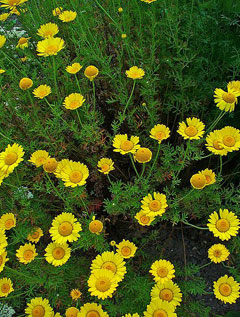 |
|
http://commons.wikimedia.org/wiki/File:Anthemis_tinctoria_Sturm41.jpg |
 |
| http://commons.wikimedia.org/wiki/File:Anthemis_tinctoria_001.JPG |
Translate this page:
Summary
Bloom Color: Yellow.
Main Bloom Time: Early summer, Late summer, Mid summer. Form: Irregular or sprawling, Upright or erect.
Physical Characteristics

 Anthemis tinctoria is an evergreen Perennial growing to 0.8 m (2ft 7in) by 0.8 m (2ft 7in).
Anthemis tinctoria is an evergreen Perennial growing to 0.8 m (2ft 7in) by 0.8 m (2ft 7in).
See above for USDA hardiness. It is hardy to UK zone 6 and is not frost tender. It is in leaf all year, in flower from July to August, and the seeds ripen from August to September. The species is hermaphrodite (has both male and female organs) and is pollinated by Bees, Lepidoptera (Moths & Butterflies), flies, beetles. The plant is self-fertile.
Suitable for: light (sandy), medium (loamy) and heavy (clay) soils and prefers well-drained soil. Suitable pH: neutral and basic (mildly alkaline) soils and can grow in very alkaline soils.
It cannot grow in the shade. It prefers dry or moist soil. The plant can tolerate maritime exposure.
UK Hardiness Map
US Hardiness Map
Synonyms
Plant Habitats
Cultivated Beds; East Wall. In. South Wall. In. West Wall. In.
Edible Uses
References More on Edible Uses
Medicinal Uses
Plants For A Future can not take any responsibility for any adverse effects from the use of plants. Always seek advice from a professional before using a plant medicinally.
Antispasmodic Emmenagogue Vesicant
The whole plant is antispasmodic, diaphoretic, emetic, emmenagogue and vesicant[4]. It is used internally as a tea, which can be made either from the flowers or the whole plant[4]. Applied externally, it is used as a poultice on piles and can also be applied to the bath water[4].The leaves are rubbed onto insect stings[222].
References More on Medicinal Uses
The Bookshop: Edible Plant Books
Our Latest books on Perennial Plants For Food Forests and Permaculture Gardens in paperback or digital formats.

Edible Tropical Plants
Food Forest Plants for Hotter Conditions: 250+ Plants For Tropical Food Forests & Permaculture Gardens.
More

Edible Temperate Plants
Plants for Your Food Forest: 500 Plants for Temperate Food Forests & Permaculture Gardens.
More

More Books
PFAF have eight books available in paperback and digital formats. Browse the shop for more information.
Shop Now
Other Uses
Dye
A distinctive yellow dye is obtained from the flowers[14, 17, 46, 61, 89, 169, 244].
Special Uses
Food Forest
References More on Other Uses
Cultivation details
Landscape Uses:Border, Container, Massing, Seashore. Prefers a well-drained sweet soil and a sunny position[1]. Grows well on chalk[187]. Plants succeed in maritime gardens[233]. Hardy to about -15°c[200]. Another report says that it is hardy to about -25°c[187]. This species has formerly been cultivated as a dye plant[61], the var. 'Kelawayi' is said to be the best form[169]. Plants are apt to over-flower and exhaust themselves. It is best to remove the flowering stems as soon as they stop flowering in order to stimulate the production of basal shoots for the following year[233]. Special Features:Attractive foliage, Fragrant foliage, Attracts butterflies, Suitable for cut flowers, Suitable for dried flowers, Extended bloom season in Zones 9A and above, Fragrant flowers, Attractive flowers or blooms.
References Carbon Farming Information and Carbon Sequestration Information
Temperature Converter
Type a value in the Celsius field to convert the value to Fahrenheit:
Fahrenheit:
The PFAF Bookshop
Plants For A Future have a number of books available in paperback and digital form. Book titles include Edible Plants, Edible Perennials, Edible Trees,Edible Shrubs, Woodland Gardening, and Temperate Food Forest Plants. Our new book is Food Forest Plants For Hotter Conditions (Tropical and Sub-Tropical).
Shop Now
Plant Propagation
Seed - surface sow March/April in a greenhouse[134]. Do not allow the soil to dry out. Light aids germination. The seed usually germinates in 2 weeks at 20°c[134]. When they are large enough to handle, prick the seedlings out into individual pots and plant them out into their permanent positions in the summer. Cuttings of soft wood early summer in a frame. Very easy[K]. Division in spring or autumn[200].
Other Names
If available other names are mentioned here
Native Range
TEMPERATE ASIA: Iran, Iraq, Israel, Jordan, Lebanon, Syria, Turkey, Russian Federation-Ciscaucasia (Ciscaucasia), Armenia, Azerbaijan, Georgia, Russian Federation (Dagestan), Russian Federation-Western Siberia (Western Siberia), Kazakhstan EUROPE: Denmark, Austria, Belgium, Switzerland, Czech Republic, Germany, Hungary, Netherlands, Poland, Slovakia, Russian Federation-European part (European part (south)), Belarus, Estonia, Lithuania, Latvia, Moldova, Ukraine (incl. Krym), Albania, Bulgaria, Bosnia and Herzegovina, Greece, Croatia, Italy (incl. Sicily), North Macedonia, Montenegro, Romania, Serbia, Slovenia, France
Weed Potential
Right plant wrong place. We are currently updating this section.
Please note that a plant may be invasive in one area but may not in your area so it's worth checking.
Conservation Status
IUCN Red List of Threatened Plants Status :

Growth: S = slow M = medium F = fast. Soil: L = light (sandy) M = medium H = heavy (clay). pH: A = acid N = neutral B = basic (alkaline). Shade: F = full shade S = semi-shade N = no shade. Moisture: D = dry M = Moist We = wet Wa = water.
Now available:
Food Forest Plants for Mediterranean Conditions
350+ Perennial Plants For Mediterranean and Drier Food Forests and Permaculture Gardens.
[Paperback and eBook]
This is the third in Plants For A Future's series of plant guides for food forests tailored to
specific climate zones. Following volumes on temperate and tropical ecosystems, this book focuses
on species suited to Mediterranean conditions—regions with hot, dry summers and cool, wet winters,
often facing the added challenge of climate change.
Read More
Expert comment
Author
L.
Botanical References
89200
Links / References
For a list of references used on this page please go here
Readers comment
© 2010, Plants For A Future. Plants For A Future is a charitable company limited by guarantee, registered in England and Wales. Charity No. 1057719, Company No. 3204567.